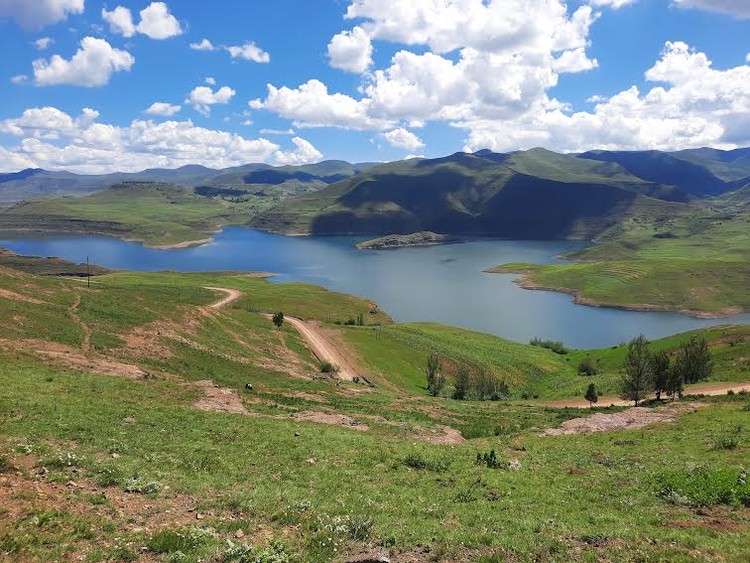Lesotho fishing company’s strange “error” on donations
Sanlei Premium Trout reported community donations of fish heads worth R2.9-million, but actually gave less than R450,000
Sanlei Premium Trout farms fish in the Katse Dam, in the Lesotho highlands. Archive photo: Sechaba Mokhethi
- SanLei Premium Trout, which farms trout in Lesotho’s Katse Dam under licence from the Lesotho Highlands Development Authority (LHDA), overstated its donations to the community, a GroundUp probe has found.
- The company told the LHDA it donated fish heads worth R2.9-million as part of its obligations to the community in 2024.
- But the true value was R450,000.
A Lesotho trout farming company overstated its donations to local communities, reporting donations of fish heads five times higher than the actual amount, a GroundUp probe has shown.
SanLei Premium Trout, a leading player in Lesotho’s fish export industry, claimed to have donated fish heads worth M2.9-million (R2.9-million) to local communities in 2024. But in fact the true value, SanLei has acknowledged, was under R450,000.
The company operates one of two commercial fish farms in Katse Dam under licence from the Lesotho Highlands Development Authority (LHDA). In order to get the licence, companies are required to file a community beneficiation plan. Compliance is monitored by the LHDA on behalf of the Department of the Environment, says LHDA environment manager Palesa Monongoaha.
But while its competitor, Katse Fish Farm, set aside 1.45% of sales revenue for community beneficiation projects, SanLei committed to donating fish heads, according to Monongoaha.
She said community beneficiation could come in different forms, “ depending on the agreement with the investors”.
SanLei CEO Dewald Fourie previously told GroundUp the company had distributed R443,851 worth of fish heads across the Katse catchment area from January to December 2024.
But according to Mpho Brown, LHDA spokesperson, Sanlei reported donating fish heads worth R2.9-million over the period. GroundUp sought clarification from the LHDA, which stood by the R2.9-million figure, insisting that it was based on SanLei’s own reports.
Questioned by GroundUp, Fourie acknowledged that the company had made a “calculation error” in its reporting to the LHDA. He said the LHDA had now been informed.
GroundUp has since asked LHDA to confirm whether SanLei did formally report the error, and what measures the regulator is taking in response. Brown has not yet responded.
Beyond donations
Among SanLei’s other community initiatives is the Katse Dam community CaRe fund. GroundUp has revealed that SanLei contributed only M5,000 to this fund. The LHDA first claimed that the company’s contribution was higher, but reversed its stance when confronted with evidence.
Fourie told GroundUp that SanLei is currently working on an updated community benefits plan, and the company is proud of what it has achieved “in terms of community support”.
“Please note that the CaRe Fund is merely one element of a broader community beneficiation programme,” he said.
“SanLei currently employs 96 permanent workers and hires more than 150 temporary employees during peak seasons — all sourced from surrounding communities,” said Fourie.
He says the company pays above the legal minimum. “The current Lesotho minimum wage for a permanent employee is M2,242. Our general workers start at M3,484,” he said.
SanLei is also involved in health initiatives, including vaccinating 250 dogs in an anti-rabies campaign, according to Fourie. The company invests both in the Katse Dam area and in businesses across Lesotho, he says.
Fourie says SanLei has ramped up its production over the past five years to the current total of over 600 metric tonnes of fish, with primary markets in South Africa and the United States.
But looming US tariffs threaten this progress. “Regarding potential US tariffs, as you know, the Lesotho government is in negotiations with the US Administration, and we’re hopeful for a positive outcome,” Fourie said.
Under the Trump administration, Lesotho was hit with a 50% tariff, one of the highest globally. Part, 40%, of that tariff was later suspended for 90 days, giving affected countries a chance to renegotiate their positions.
Support independent journalism
Donate using Payfast

Don't miss out on the latest news
We respect your privacy, and promise we won't spam you.
Next: Eastern Cape teacher accused of beating learner with a hosepipe
Previous: Judge slams Home Affairs for “unintelligible, illogical babble” in gay case
© 2025 GroundUp. This article is licensed under a Creative Commons Attribution-NoDerivatives 4.0 International License.
You may republish this article, so long as you credit the authors and GroundUp, and do not change the text. Please include a link back to the original article.
We put an invisible pixel in the article so that we can count traffic to republishers. All analytics tools are solely on our servers. We do not give our logs to any third party. Logs are deleted after two weeks. We do not use any IP address identifying information except to count regional traffic. We are solely interested in counting hits, not tracking users. If you republish, please do not delete the invisible pixel.

